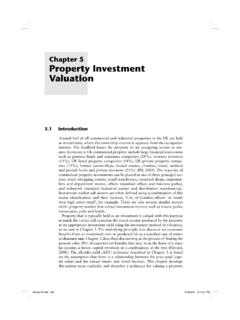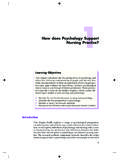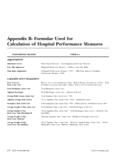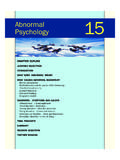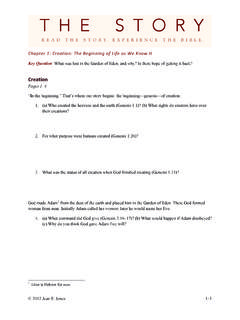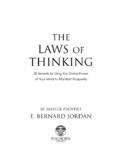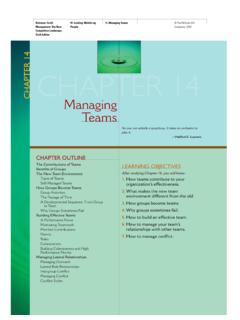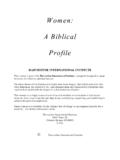Transcription of What Is Behaviorism? - Wiley-Blackwell
1 Part OneWhat Is Behaviorism? behaviorism has been a controversial topic. Some objections arise fromcorrect understanding, but misconceptions about behaviorism three chapters in this part aim to clarify what might be called the philosophical stance of that is genuinely controversial about behaviorism stems from itsprimary idea, that a science of behavior is possible. At some point inits history, every science has had to exorcise imagined causes ( hiddenagents) that supposedly lie behind or under the surface of naturalevents. chapter 1 explains how behaviorists denial of hidden agentsleads to a genuine controversy, the question of whether behavior isfree or 2 aims to forestall misconceptions that may arise becausebehaviorism has changed over time.
2 An earlier version, called methodo-logical behaviorism , was based on realism, the view that all experienceis caused by an objective, real world outside of and apart from aperson s subjective, inner world. Realism may be contrasted withpragmatism, which is silent about the origin of experience, but pointsinstead to the usefulness of trying to understand and make sense outof our experiences. A later version of behaviorism , called radical beha-viorism, rests on pragmatism, rather than on realism. Anyone failingto understand this difference is likely to misunderstand the criticalaspect of radical behaviorism , its rejection of behaviorists critique of mentalism, explained in chapter 3,underlies the remainder of the book, because it requires behavioriststo suggest nonmentalistic explanations of behavior ( Part Two) andnonmentalistic solutions to social problems ( Part Three).
3 2 What Is Behaviorism? behaviorism : Definition and History3 chapter 1 behaviorism :Definition and HistoryThe central idea in behaviorism can be stated simply: A science ofbehavior is possible. Behaviorists have diverse views about what thisproposition means, and particularly about what science is and whatbehavior is, but every behaviorist agrees that there can be a science behaviorists add that the science of behavior should be psy-chology. This causes contention because many psychologists rejectthe idea that psychology is a science at all, and others who regard it asa science consider its subject matter something other than behaviorists have come to call the science of behavior behavioranalysis.
4 The debate continues as to whether behavior analysis is a partof psychology, the same as psychology, or independent of psychology,but professional organizations, such as the Association for BehaviorAnalysis, and journals, such as The Behavior Analyst, Journal of theExperimental Analysis of Behavior, and Journal of Applied Behavior Analysis,give the field an behaviorism is a set of ideas about this science called beha-vior analysis, not the science itself, properly speaking behaviorism isnot science, but philosophy of science. As philosophy about behavior,however, it touches topics near and dear to us: why we do what wedo, and what we should and should not do.
5 behaviorism offers analternative view that often runs counter to traditional thinking aboutaction, because traditional views have been unscientific. We will seein later chapters that it sometimes takes us in directions radicallydifferent from conventional thinking. This chapter covers some of thehistory of behaviorism and one of its most immediate implications, Is Behaviorism? Historical BackgroundFrom Philosophy to ScienceAll the sciences astronomy, physics, chemistry, biology had theirorigins in, and eventually broke free from, philosophy. Before astonomyand physics existed as sciences, for example, philosophers speculatedabout the arrangement of the natural universe by starting from assump-tions about God or some other ideal standard and reasoning to con-clusions about the way the universe must be.
6 For example, if allimportant events seemed to occur on the earth, then the earth must bethe center of the universe. Since a circle was the most perfect shape,the sun must travel about the earth in a circular orbit. The moon musttravel in another, closer, circular orbit, and the stars must be in asphere, the most perfect three-dimensional form, around the whole.(To this day, the sun, the moon, and the stars are called heavenlybodies, because they were supposed to be perfect.)The sciences of astronomy and physics were born when individualsbegan trying to understand natural objects and phenomena by observ-ing them. When Galilei Galileo (1564 1642) trained a telescope onthe moon, he observed that its crater-scarred landscape was far fromthe perfect sphere the philosophers supposed it to be.
7 Contributing tophysics also, Galileo recorded the motion of falling objects by rollinga ball down a chute. In describing his findings, Galileo helped inventthe modern notions of velocity and acceleration. Isaac Newton (1642 1727) added concepts like force and inertia to create a powerfuldescriptive scheme for understanding motions of bodies on the earthas well as heavenly bodies such as the creating the science of physics, Galileo, Newton, and other thinkersof the Enlightenment broke with philosophy. Philosophy reasons fromassumptions to conclusions. Its arguments take the form If this wereso, then that would be so. Science proceeds in the opposite direction: This is observed; what could be true that would lead to such anobservation, and what other observations would it lead to?
8 Philo-sophical truth is absolute; as long as the assumptions are spelled out andthe reasoning is correct, the conclusions must follow. Scientific truthis always relative and provisional; it is relative to observation andsusceptible to disconfirmation by new observations. For a long time,astronomers thought there were only seven planets, but then an eighthand a ninth were discovered. Philosophical assumptions concernedabstractions beyond the natural universe: God, harmony, ideal shapes, behaviorism : Definition and History5and so on. Scientific assumptions used in theory-building concernonly the natural universe and the way it might be organized. ThoughNewton was a theologian as well as a physicist, he separated the twoactivities.
9 About physics, he said, Hypotheses non fingo ( I do not makehypotheses), meaning that when studying physics he had no concernfor any supernatural entities or principles that is, for anything out-side the natural universe itself. The reason the ocean has tides is notGod s will but the gravitational pull of the moon as it revolves aroundthe well as physics, the ancient Greeks speculated about such as Heraclitus, Empedocles, and Aristotle speculatedthat matter varied in its properties because it was endowed with cer-tain qualities, essences, or principles. Aristotle suggested four qualities:hot, cold, wet, and dry. If a substance was a liquid, it possessed more ofthe wet quality; if a solid, more of the dry.
10 As centuries passed, the listof qualities or essences lengthened. Things that grew hot were said topossess the inner essence caloric. Materials that burned were said topossess phlogiston. These essences were considered real substanceshidden somewhere within the materials. When thinkers turned awayfrom speculation about hidden essences and began making and inter-relating careful observations of material change, chemistry was Lavoisier (1743 94), among others, developed the conceptof oxygen from the careful observation of weights. Lavoisier foundthat when the metal lead is burned and transformed into a yellowpowder ( lead oxide) in a closed vessel, the powder weighs more thanthe original metal, and yet the entire vessel retains the same reasoned that this could occur if the metal combined withsome material in the air.




